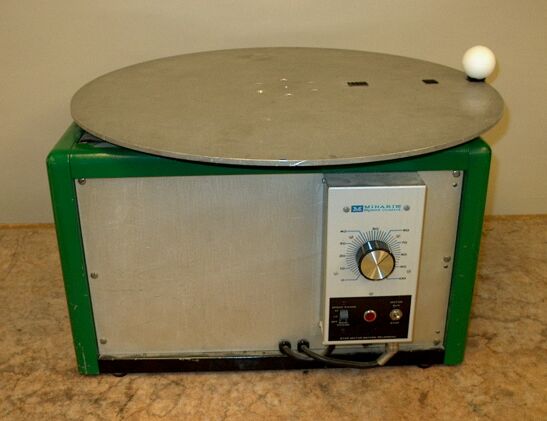
A ball on a variable-speed turntable illustrates the kinematics of circular motion.

In this demonstration we consider the motion of the ball held by Velcro® near the edge of the turntable platter. If you set the speed control at a particular value and then turn the power on, the turntable rotates at a constant speed, taking the ball in a circular path, also at a constant speed. This speed is the magnitude of the tangential velocity of the ball, that is, its velocity at any instant, perpendicular to the radius of the circular path. The direction of the velocity is constantly changing as the ball travels around the circle. If we consider two points along the ball’s path, P and P′, if we call the ball’s velocity at P v, then its velocity at P′ is v′, which equals v + Δv. The angle between v and v′ is the same as the angle between the radius of the circle, r, to point P and the radius to point P′ (since v is always perpendicular to r, and is thus displaced through the same angle as r). If we call the increment of time during which the ball travels from P to P′ Δt, the length of the arc from P to P′ is vΔt, where v is the tangential speed of the ball. If Δt is small, the length of this arc is almost equal to that of the line segment between P and P′, and because the triangles formed by v, v′ and Δv, and by the two radii, r, and segment PP′ are similar, Δv/v ≈ vΔt/r, which gives Δv/Δt ≈ v2/r. Also, as Δv gets smaller, it gets closer to being perpendicular to both v and v′, and thus closer to pointing (inward) along r. In the limit as Δt goes to zero, vΔt = PP′, and we have a = dv/dt = v2/r. Because a points in toward the center of the circle, it is called centripetal acceleration. (“Centripetal” means “center-seeking.”) Because a is always perpendicular to v and always points toward the center of the circle, it (like v) is always changing direction. So, for an object moving at constant speed along a circular path, the magnitude of the acceleration is constant, but the acceleration, a, is not.
What provides the acceleration to keep the ball moving around the circle is the Velcro® attachment at the edge of the turntable (or either of the other two, should you choose to attach the ball at a different radius).
References:
1) Resnick, Robert and Halliday, David. Physics, Part One, Third Edition (New York: John Wiley and Sons, 1977), pp. 59-61.